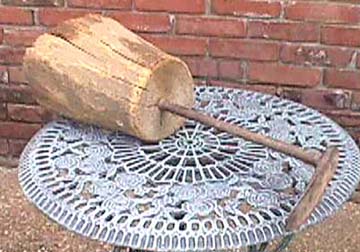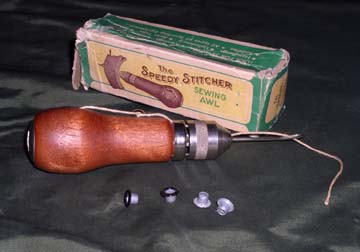
shoe last (artifact #17)

This shoe last belonged to Grandfather Charles Arthur Doyle. This is another artifact handed down to my father and on to me. From my earliest memories it was always kept in the tool room of the crib. There is little known of the history of the tool other than it being in his possession and Dad inheriting it. My guess is that he bought it at a farm auction or from an individual, this is based solely upon the wooden log used as a base. The original base was probably lost prior to coming into the possession of Granddad and, without question, the new base was installed by him. The wooden piece certainly provided a large footprint as a stand.
Note the log has weathered well, considering the age, use and abuse over the years. The oil stains show that during storage it was not well protected. It sat upon the ground for many years and there is some dry rot on one side. It will not set straight due to this deterioration. Age has allowed the log to weather crack, but overall it is in good shape. The upright shaft is still tightly fastened to the log.
Dad had our own shoe last, originally belonging to Grandfather Arnold, my motherís dad. It was made as a one-piece casting with two sizes for soles of shoes and an upright anvil for the heel. It was salvaged from the ashes of our home, after the fire, and has been used as a doorstop in recent years. I gave it to my son last year.
Many of these artifacts are a reminder of times back in the 1800ís. Life was tough and not all survived. Grandfather Arnold died of pneumonia when Mother was a girl. In those days, there was a fireplace where the wife cooked and also provided heating for the entire house. It can be very cold in the Ozark Mountains. At the age of 16, my mother came close to dying of Typhoid Fever, had to learn to walk again, and was never sure footed following the illness.
Grandfather Doyle farmed with oxen in his early life. They were shod with a different shoe than horses. You can see that footwear was important for man and animals alike. The head of the household was responsible for making and repairing shoes unless there was a cobbler from the Old Country living in the area. Children often times went barefooted. One pair of shoes may have been provided for the start of school and that was the only pair for the year.
My sisterís father-in-law, Vernon Salsbury, still living on his farm and active on a tractor and a four-wheeler at the age of 98, recently drove his four-wheeler into the city to see his lawyer some 15 miles distant. His brother Stant worked on a public job, building roads, pushing a wheelbarrow, loaded with dirt or rock when they were boys, barefooted that is.
When I was a boy, the song ďSanta Fe TrailĒ, about the prairie schooner wending its way westward, was still a favorite to many people. This of course was in the Thirties and before the rumblings that proceeded WW2. History was being changed forever for the USA and the whole world, and old USA history was mostly forgotten in the daily life of citizens. Fortunately I always had shoes to wear, although sometimes they cramped my toes as I outgrew them. WW2 was the only time footwear was a real problem as all things were rationed during that period. Many times, as a tack cut into my foot, either Dad or myself would take the shoe to the last. It was quite common to half sole shoes or put on a new set of heels. The soles were always tacked on and the heels nailed on. A shoe last was a necessity, not just in pioneering days.
A shoe last serves as a holder and anvil for repairing shoes. Replacement soles, half-soles, heels, and insoles were available by mail order or from a general store in a selection of sizes. There was a choice of material, hard rubber or leather, and you could choose a color, brown or black. Special nails were used, which were also widely available. Eyelets and hooks for laces were common sundry items and sewing awls and accessories, especially for shoe repair, were available.

This is a sewing awl for leather. A spool for the waxed linen twine is contained in the hollow handle. Extra needles are stowed out of sight under the chuck. Bill Franklin reports that it is useless for anything but the thin-leather uppers of footwear for two reasons : The tool isn't sturdy or large enough for cow hide, soles, and most harness leather. Also, one must have access to the back side to thread the line through each loop, forming a lock stitch. It would be okay to work with holster leather, split cow hide, and horse hide. The thing was made by Stewart Mfg. Co., Worcester, Mass. It was new in 1952, rarely used, and stored in its original box.
The cobbler would pry the worn heel from a shoe. He would dig any nails from the sole and, if only a half sole was to be used, slice the worn part of the sole away at a shallow angle, forming a bevel. A replacement sole or half sole might be spread with glue and clamped in place with a wood vise or C-clamps. The glue helped hold the part in place, because the arch of a shoe is not flat, until nails were driven and also served as water resistance. Nails were driven with the shoe mounted on the last. Any nails protruding inside the shoe were peened flat before the insole was glued in place. The last step in shoe repair is to trim the new parts to the original shoe contour by paring with a knife or grinding with an abrasive wheel.
Before the war, leather was the preferred material for shoe soles and heels.
Leather is hateful because footing is slippery on all surfaces, but the hard rubber of that day didnít wear
well. As a war time expedient, synthetic butyl rubber was developed for tires and
inner tubes. A similar substance, neoprene, revolutionized the shoe industry.
Neoprene wears well, is flexible, gives good grip, is oil resistant, and doesnít make leatherís
characteristic clomping sound on hard surfaces. Neoprene was king, until
disposable footwear came into vogue, and still is favored for use with stout leather work
shoes and boots.
Charles D. Doyle 5/8/03 (changes 5/24 and 8/20/03)